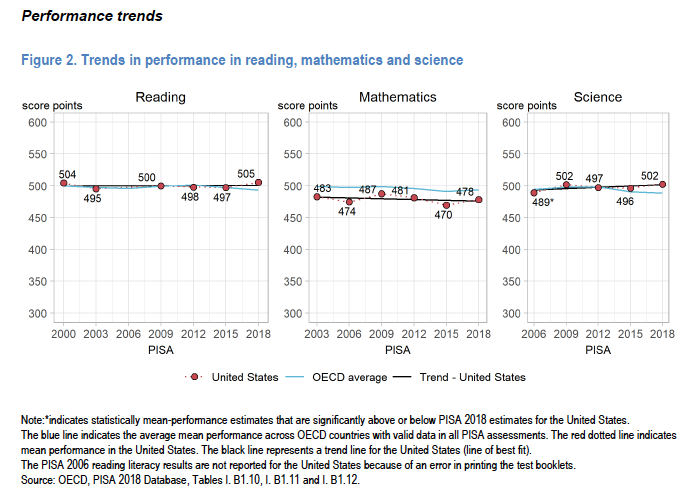The OECD administers the Programme for International Student Assessment (PISA) tests to 15-year-old students from around the world, and results from the 2018 tests were released today. The United States is stuck in a rut.
Students in the United States performed above the OECD average in reading (505 score points) and science (502), and below the OECD average in mathematics (478). Their scores were similar to those of students in Australia, Germany, New Zealand, Sweden and the United Kingdom in at least two of these three subjects. The trend lines of United States’ mean performance in reading since 2000, mathematics since 2003 and science since 2006 are stable, with no significant improvement or decline. Nevertheless, in reading, the share of 15-year-old students who scored at Level 5 or 6 (top performers) increased by almost 4 percentage points – a statistically significant increase – between 2009 and 2018, to 13.5%.
The New York Times notes that the United States has poured billions into school reform efforts, including No Child Left Behind, Race to the Top, the Common Core State Standards, the Every Student Succeeds Act. NYT reporter Dana Goldstein writes,
There is no consensus on why the performance of struggling students is declining. Education experts argue vociferously about a range of potential causes, including school segregation, limited school choice, funding inequities, family poverty, too much focus on test prep and a dearth of instruction in basic skills like phonics.
Interestingly, the achievement gap in the United States is similar to other nations.
Mr. Schleicher, of the Organization for Economic Cooperation and Development, said it was a common misconception that socioeconomic achievement gaps in the United States were much larger than those in the rest of the world. Three percent of American children from poor families were top performers in reading, compared with an average of 4 percent of poor children among O.E.C.D. countries.
In math, socioeconomic status explained 16 percent of the variation in American performance, similar to the average of 14 percent across O.E.C.D. nations.
Some will try to explain away the results by dismissing international assessments or claiming that the United States is fundamentally different than other participating nations. Tell that to the employers who will be recruiting talent from the top-scoring nations on the tests.



